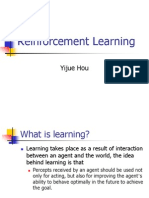0% found this document useful (0 votes)
67 views11 pagesReinforcement Learning
This document discusses reinforcement learning and key concepts like the agent, environment, actions, rewards, and policy. It explains reinforcement learning works through trial and error as the agent learns to maximize rewards. The text also covers model-free algorithms like Q-learning and temporal difference learning which aim to learn the optimal policy without knowing the environment's dynamics.
Uploaded by
Reddy BunnyCopyright
© © All Rights Reserved
We take content rights seriously. If you suspect this is your content, claim it here.
Available Formats
Download as PDF, TXT or read online on Scribd
0% found this document useful (0 votes)
67 views11 pagesReinforcement Learning
This document discusses reinforcement learning and key concepts like the agent, environment, actions, rewards, and policy. It explains reinforcement learning works through trial and error as the agent learns to maximize rewards. The text also covers model-free algorithms like Q-learning and temporal difference learning which aim to learn the optimal policy without knowing the environment's dynamics.
Uploaded by
Reddy BunnyCopyright
© © All Rights Reserved
We take content rights seriously. If you suspect this is your content, claim it here.
Available Formats
Download as PDF, TXT or read online on Scribd
/ 11


























































